SKODA OCTAVIA 2005 1.G / (1U) Owner's Manual
Manufacturer: SKODA, Model Year: 2005, Model line: OCTAVIA, Model: SKODA OCTAVIA 2005 1.G / (1U)Pages: 315, PDF Size: 11.8 MB
Page 171 of 315
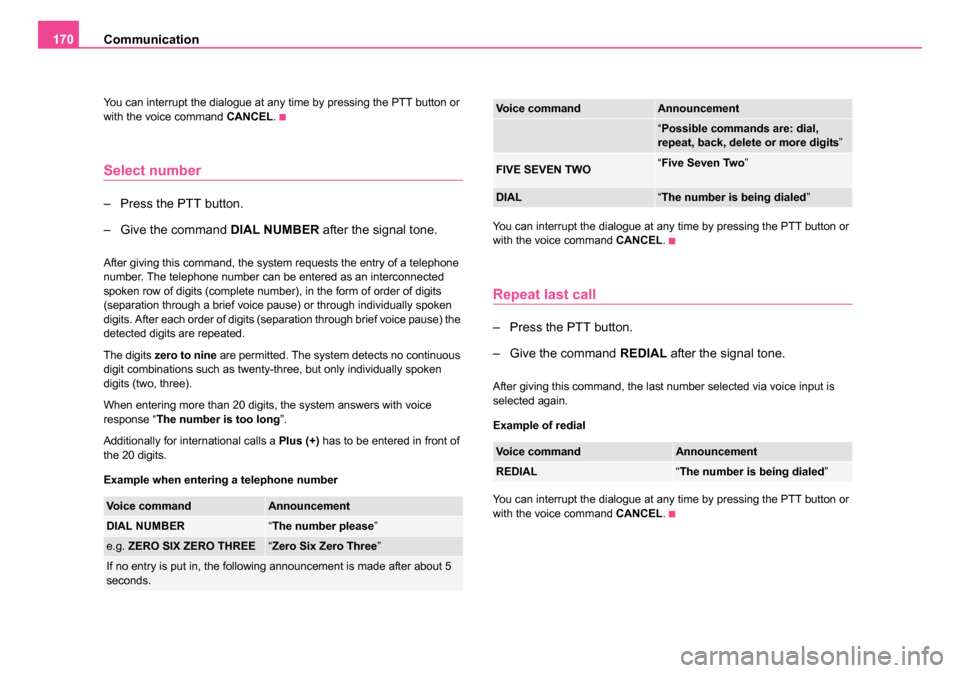
Communication
170
You can interrupt the dialogue at any time by pressing the PTT button or
with the voice command CANCEL.
Select number
– Press the PTT button.
– Give the command DIAL NUMBER after the signal tone.
After giving this command, the system requests the entry of a telephone
number. The telephone number can be entered as an interconnected
spoken row of digits (complete number), in the form of order of digits
(separation through a brief voice pause) or through individually spoken
digits. After each order of digits (separation through brief voice pause) the
detected digits are repeated.
The digits zero to nine are permitted. The system detects no continuous
digit combinations such as twenty-three, but only individually spoken
digits (two, three).
When entering more than 20 digits, the system answers with voice
response “ The number is too long ”.
Additionally for international calls a Plus (+) has to be entered in front of
the 20 digits.
Example when entering a telephone number You can interrupt the dialogue at any time by pressing the PTT button or
with the voice command
CANCEL.
Repeat last call
– Press the PTT button.
– Give the command REDIAL after the signal tone.
After giving this command, the last number selected via voice input is
selected again.
Example of redial
You can interrupt the dialogue at any time by pressing the PTT button or
with the voice command CANCEL.
Voice commandAnnouncement
DIAL NUMBER“The number please ”
e.g. ZERO SIX ZERO THREE“Zero Six Zero Three ”
If no entry is put in, the following announcement is made after about 5
seconds.
“Possible commands are: dial,
repeat, back, delete or more digits”
FIVE SEVEN TWO“ Five Seven Two ”
DIAL“The number is being dialed ”
Voice commandAnnouncement
REDIAL“The number is being dialed ”
Voice commandAnnouncement
s24s.book Page 170 Thursday, November 24, 2005 12:27 PM
Page 172 of 315
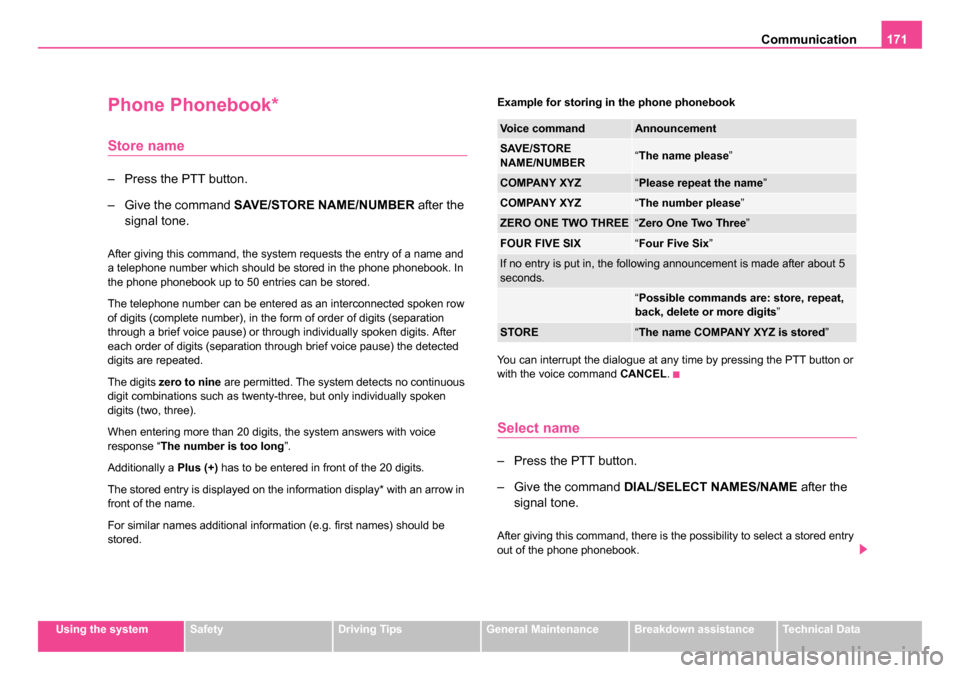
Communication171
Using the systemSafetyDriving TipsGeneral MaintenanceBreakdown assistanceTechnical Data
Phone Phonebook*
Store name
– Press the PTT button.
– Give the command SAVE/STORE NAME/NUMBER after the
signal tone.
After giving this command, the system requests the entry of a name and
a telephone number which should be stored in the phone phonebook. In
the phone phonebook up to 50 entries can be stored.
The telephone number can be entered as an interconnected spoken row
of digits (complete number), in the form of order of digits (separation
through a brief voice pause) or through individually spoken digits. After
each order of digits (separation through brief voice pause) the detected
digits are repeated.
The digits zero to nine are permitted. The system detects no continuous
digit combinations such as twenty-three, but only individually spoken
digits (two, three).
When entering more than 20 digits, the system answers with voice
response “ The number is too long ”.
Additionally a Plus (+) has to be entered in front of the 20 digits.
The stored entry is displayed on the information display* with an arrow in
front of the name.
For similar names additional information (e.g. first names) should be
stored. Example for storing in the phone phonebook
You can interrupt the dialogue at any time by pressing the PTT button or
with the voice command
CANCEL.
Select name
– Press the PTT button.
– Give the command DIAL/SELECT NAMES/NAME after the
signal tone.
After giving this command, there is the possibility to select a stored entry
out of the phone phonebook.
Voice commandAnnouncement
SAVE/STORE
NAME/NUMBER“ The name please ”
COMPANY XYZ“Please repeat the name ”
COMPANY XYZ“The number please”
ZERO ONE TWO THREE“Zero One Two Three ”
FOUR FIVE SIX“Four Five Six”
If no entry is put in, the following announcement is made after about 5
seconds.
“Possible commands are: store, repeat,
back, delete or more digits ”
STORE“The name COMPANY XYZ is stored ”
s24s.book Page 171 Thursday, November 24, 2005 12:27 PM
Page 173 of 315
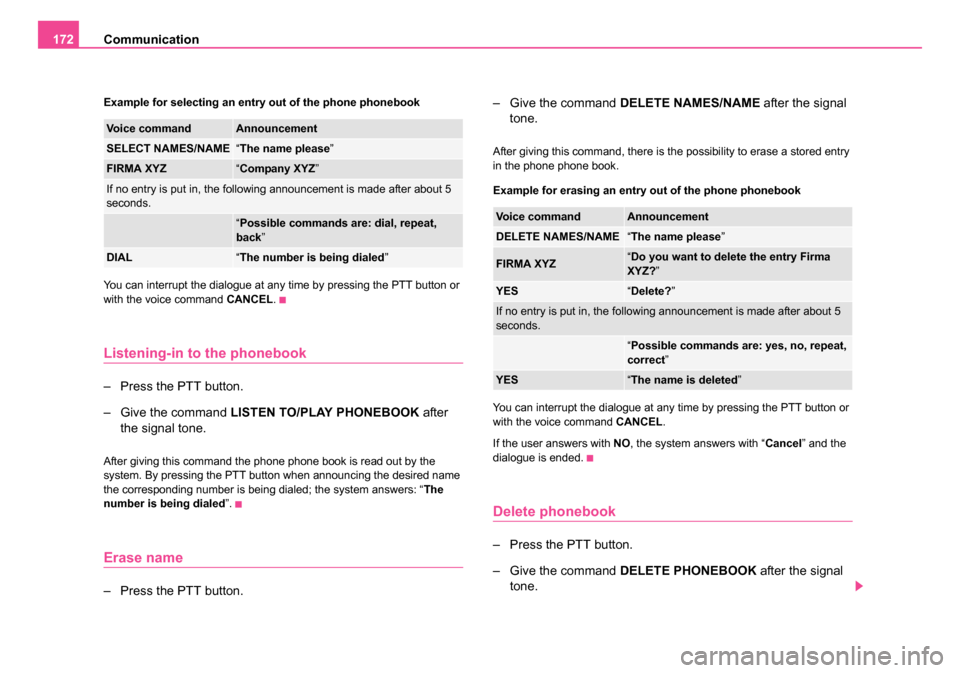
Communication
172
Example for selecting an entry out of the phone phonebook
You can interrupt the dialogue at any time by pressing the PTT button or
with the voice command CANCEL.
Listening-in to the phonebook
– Press the PTT button.
– Give the command LISTEN TO/PLAY PHONEBOOK after
the signal tone.
After giving this command the phone phone book is read out by the
system. By pressing the PTT button when announcing the desired name
the corresponding number is being dialed; the system answers: “ The
number is being dialed ”.
Erase name
– Press the PTT button. – Give the command
DELETE NAMES/NAME after the signal
tone.
After giving this command, there is the possibility to erase a stored entry
in the phone phone book.
Example for erasing an entry out of the phone phonebook
You can interrupt the dialogue at any time by pressing the PTT button or
with the voice command CANCEL.
If the user answers with NO, the system answers with “ Cancel” and the
dialogue is ended.
Delete phonebook
– Press the PTT button.
– Give the command DELETE PHONEBOOK after the signal
tone.
Voice commandAnnouncement
SELECT NAMES/NAME“ The name please”
FIRMA XYZ“Company XYZ”
If no entry is put in, the following announcement is made after about 5
seconds.
“Possible commands are: dial, repeat,
back ”
DIAL“The number is being dialed ”
Voice commandAnnouncement
DELETE NAMES/NAME“The name please ”
FIRMA XYZ“Do you want to delete the entry Firma
XYZ? ”
YES“Delete? ”
If no entry is put in, the following announcement is made after about 5
seconds.
“Possible commands are: yes, no, repeat,
correct ”
YES“The name is deleted ”
s24s.book Page 172 Thursday, November 24, 2005 12:27 PM
Page 174 of 315
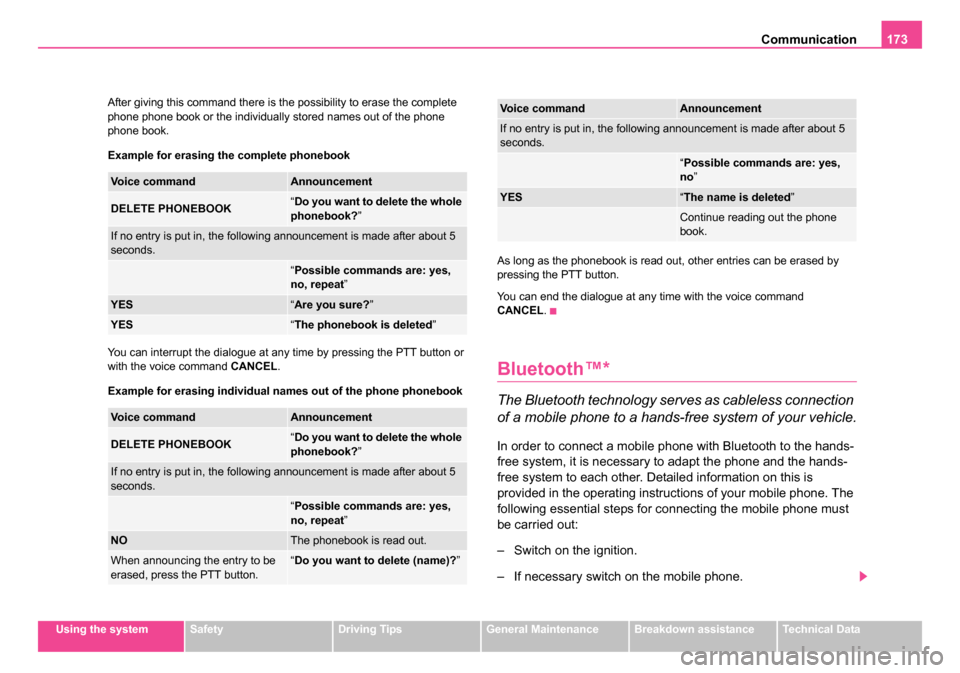
Communication173
Using the systemSafetyDriving TipsGeneral MaintenanceBreakdown assistanceTechnical Data
After giving this command there is the possibility to erase the complete
phone phone book or the individually stored names out of the phone
phone book.
Example for erasing the complete phonebook
You can interrupt the dialogue at any time by pressing the PTT button or
with the voice command
CANCEL.
Example for erasing individual names out of the phone phonebook As long as the phonebook is read out, other entries can be erased by
pressing the PTT button.
You can end the dialogue at any time with the voice command
CANCEL
.
Bluetooth™*
The Bluetooth technology serves as cableless connection
of a mobile phone to a hands-free system of your vehicle.
In order to connect a mobile phone with Bluetooth to the hands-
free system, it is necessary to adapt the phone and the hands-
free system to each other. Detailed information on this is
provided in the operating instructions of your mobile phone. The
following essential steps for connecting the mobile phone must
be carried out:
– Switch on the ignition.
– If necessary switch on the mobile phone.
Voice commandAnnouncement
DELETE PHONEBOOK“Do you want to delete the whole
phonebook? ”
If no entry is put in, the following announcement is made after about 5
seconds.
“Possible commands are: yes,
no, repeat ”
YES“Are you sure? ”
YES“The phonebook is deleted ”
Voice commandAnnouncement
DELETE PHONEBOOK“Do you want to delete the whole
phonebook? ”
If no entry is put in, the following announcement is made after about 5
seconds.
“Possible commands are: yes,
no, repeat ”
NOThe phonebook is read out.
When announcing the entry to be
erased, press the PTT button.“Do you want to delete (name)? ”
If no entry is put in, the following announcement is made after about 5
seconds.
“Possible commands are: yes,
no ”
YES“The name is deleted ”
Continue reading out the phone
book.
Voice commandAnnouncement
s24s.book Page 173 Thursday, November 24, 2005 12:27 PM
Page 175 of 315
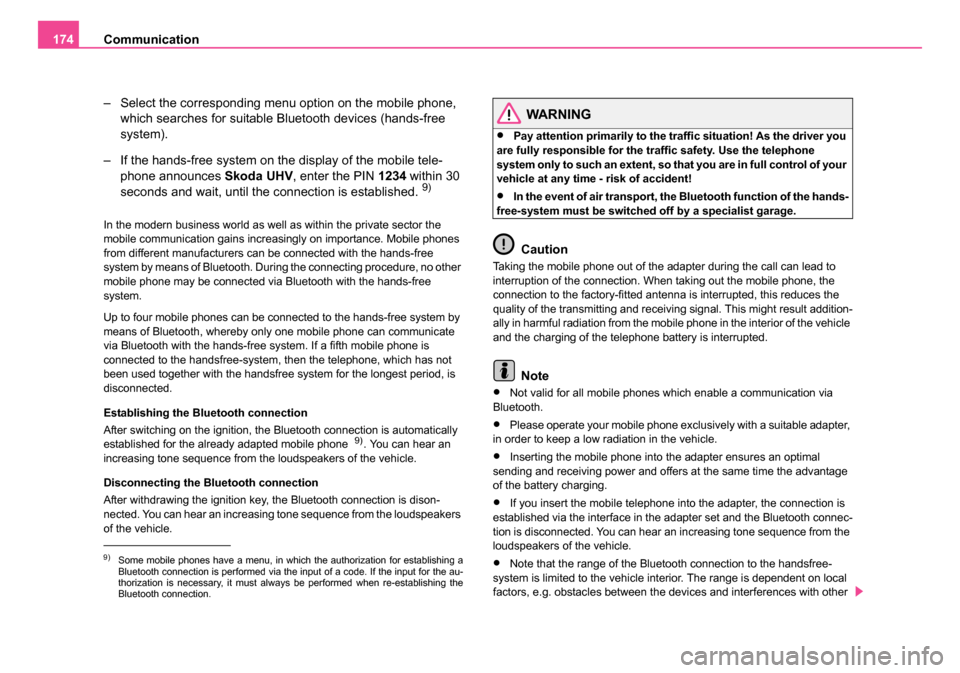
Communication
174
– Select the corresponding menu option on the mobile phone, which searches for suitable Bluetooth devices (hands-free
system).
– If the hands-free system on the display of the mobile tele- phone announces Skoda UHV, enter the PIN 1234 within 30
seconds and wait, until the connection is established.
9)
In the modern business world as well as within the private sector the
mobile communication gains increasingly on importance. Mobile phones
from different manufacturers can be connected with the hands-free
system by means of Bluetooth. During the connecting procedure, no other
mobile phone may be connected via Bluetooth with the hands-free
system.
Up to four mobile phones can be connected to the hands-free system by
means of Bluetooth, whereby only one mobile phone can communicate
via Bluetooth with the hands-free system. If a fifth mobile phone is
connected to the handsfree-system, then the telephone, which has not
been used together with the handsfree system for the longest period, is
disconnected.
Establishing the Bluetooth connection
After switching on the ignition, the Bluetooth connection is automatically
established for the already adapted mobile phone
9). You can hear an
increasing tone sequence from the loudspeakers of the vehicle.
Disconnecting the Bluetooth connection
After withdrawing the ignition key, the Bluetooth connection is dison-
nected. You can hear an increasing tone sequence from the loudspeakers
of the vehicle.
WARNING
•Pay attention primarily to the traffic situation! As the driver you
are fully responsible for the traffic safety. Use the telephone
system only to such an extent, so that you are in full control of your
vehicle at any time - risk of accident!
•In the event of air transport, the Bluetooth function of the hands-
free-system must be switched off by a specialist garage.
Caution
Taking the mobile phone out of the adapter during the call can lead to
interruption of the connection. When taking out the mobile phone, the
connection to the factory-fitted antenna is interrupted, this reduces the
quality of the transmitting and receiving signal. This might result addition-
ally in harmful radiation from the mobile phone in the interior of the vehicle
and the charging of the telephone battery is interrupted.
Note
•Not valid for all mobile phones which enable a communication via
Bluetooth.
•Please operate your mobile phone exclusively with a suitable adapter,
in order to keep a low radiation in the vehicle.
•Inserting the mobile phone into the adapter ensures an optimal
sending and receiving power and offers at the same time the advantage
of the battery charging.
•If you insert the mobile telephone into the adapter, the connection is
established via the interface in the adapter set and the Bluetooth connec-
tion is disconnected. You can hear an increasing tone sequence from the
loudspeakers of the vehicle.
•Note that the range of the Bluetooth connection to the handsfree-
system is limited to the vehicle interior. The range is dependent on local
factors, e.g. obstacles between the devices and interferences with other 9)Some mobile phones have a menu, in which the authorization for establishing a
Bluetooth connection is performed via the input of a code. If the input for the au-
thorization is necessary, it must always be performed when re-establishing the
Bluetooth connection.
s24s.book Page 174 Thursday, November 24, 2005 12:27 PM
Page 176 of 315
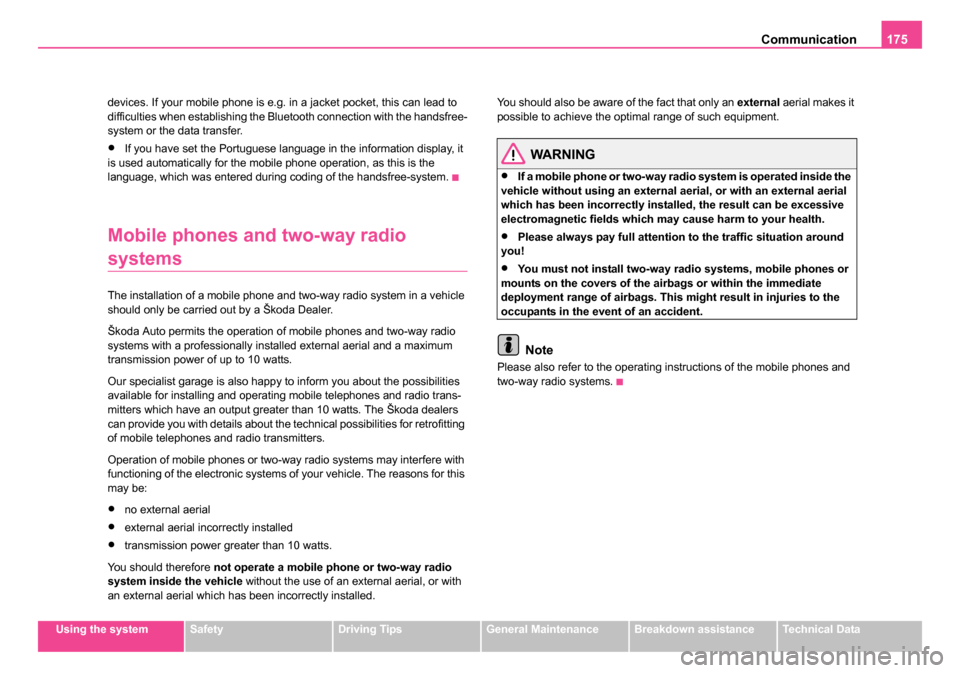
Communication175
Using the systemSafetyDriving TipsGeneral MaintenanceBreakdown assistanceTechnical Data
devices. If your mobile phone is e.g. in a jacket pocket, this can lead to
difficulties when establishing the Bluetooth connection with the handsfree-
system or the data transfer.
•If you have set the Portuguese language in the information display, it
is used automatically for the mobile phone operation, as this is the
language, which was entered during coding of the handsfree-system.
Mobile phones and two-way radio
systems
The installation of a mobile phone and two-way radio system in a vehicle
should only be carried out by a Škoda Dealer.
Škoda Auto permits the operation of mobile phones and two-way radio
systems with a professionally installed external aerial and a maximum
transmission power of up to 10 watts.
Our specialist garage is also happy to inform you about the possibilities
available for installing and operating mobile telephones and radio trans-
mitters which have an output greater than 10 watts. The Škoda dealers
can provide you with details about the technical possibilities for retrofitting
of mobile telephones and radio transmitters.
Operation of mobile phones or two-way radio systems may interfere with
functioning of the electronic systems of your vehicle. The reasons for this
may be:
•no external aerial
•external aerial incorrectly installed
•transmission power greater than 10 watts.
You should therefore not operate a mobile phone or two-way radio
system inside the vehicle without the use of an external aerial, or with
an external aerial which has been incorrectly installed. You should also be aware of the fact that only an
external aerial makes it
possible to achieve the optimal range of such equipment.
WARNING
•If a mobile phone or two-way radio system is operated inside the
vehicle without using an external aerial, or with an external aerial
which has been incorrectly installed, the result can be excessive
electromagnetic fields which may cause harm to your health.
•Please always pay full attention to the traffic situation around
you!
•You must not install two-way radio systems, mobile phones or
mounts on the covers of the airbags or within the immediate
deployment range of airbags. This might result in injuries to the
occupants in the event of an accident.
Note
Please also refer to the operating instructions of the mobile phones and
two-way radio systems.
s24s.book Page 175 Thursday, November 24, 2005 12:27 PM
Page 177 of 315
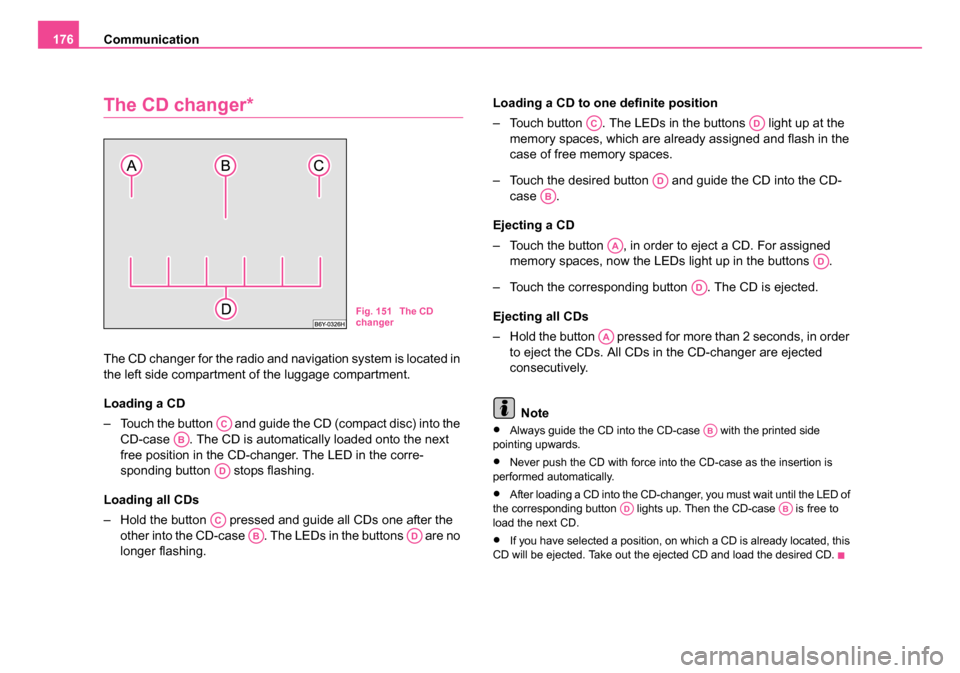
Communication
176
The CD changer*
The CD changer for the radio and navigation system is located in
the left side compartment of the luggage compartment.
Loading a CD
– Touch the button and guide the CD (compact disc) into the
CD-case . The CD is automatically loaded onto the next
free position in the CD-changer. The LED in the corre-
sponding button stops flashing.
Loading all CDs
– Hold the button pressed and guide all CDs one after the other into the CD-case . The LEDs in the buttons are no
longer flashing. Loading a CD to one definite position
– Touch button . The LEDs in the buttons light up at the
memory spaces, which are already assigned and flash in the
case of free memory spaces.
– Touch the desired button and guide the CD into the CD- case .
Ejecting a CD
– Touch the button , in order to eject a CD. For assigned memory spaces, now the LEDs light up in the buttons .
– Touch the corresponding button . The CD is ejected.
Ejecting all CDs
– Hold the button pressed for more than 2 seconds, in order to eject the CDs. All CDs in the CD-changer are ejected
consecutively.
Note
•Always guide the CD into the CD-case with the printed side
pointing upwards.
•Never push the CD with force into the CD-case as the insertion is
performed automatically.
•After loading a CD into the CD-changer, you must wait until the LED of
the corresponding button lights up. Then the CD-case is free to
load the next CD.
•If you have selected a position, on which a CD is already located, this
CD will be ejected. Take out the ejected CD and load the desired CD.
Fig. 151 The CD
changer
AC
AB
AD
AC
ABAD
ACAD
AD
AB
AA
AD
AD
AA
AB
ADAB
s24s.book Page 176 Thursday, November 24, 2005 12:27 PM
Page 178 of 315
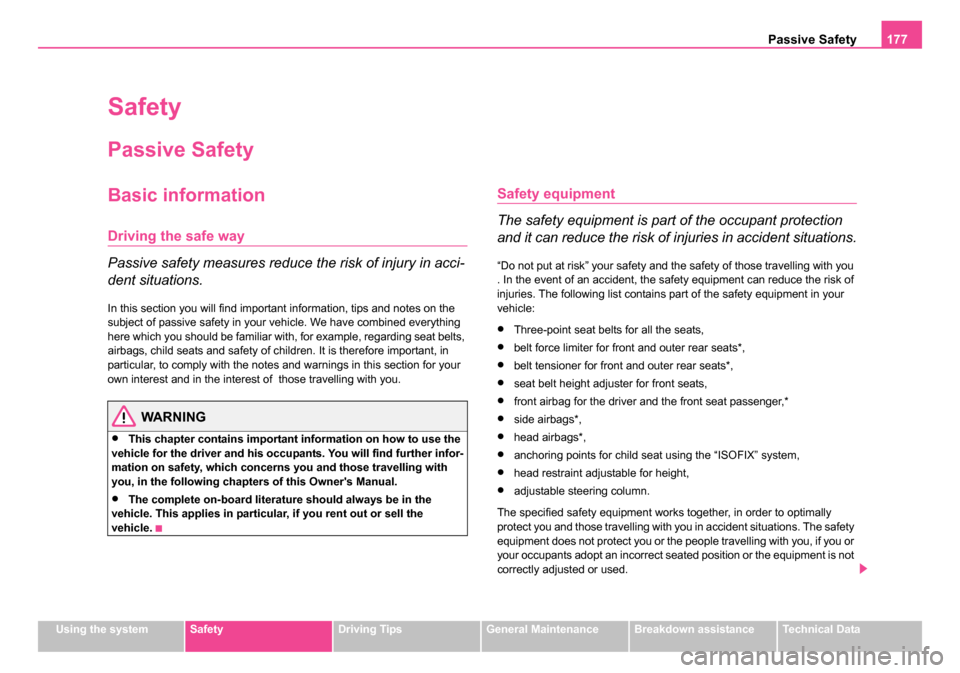
Passive Safety177
Using the systemSafetyDriving TipsGeneral MaintenanceBreakdown assistanceTechnical Data
Safety
Passive Safety
Basic information
Driving the safe way
Passive safety measures reduce the risk of injury in acci-
dent situations.
In this section you will find important information, tips and notes on the
subject of passive safety in your vehicle. We have combined everything
here which you should be familiar with, for example, regarding seat belts,
airbags, child seats and safety of children. It is therefore important, in
particular, to comply with the notes and warnings in this section for your
own interest and in the interest of those travelling with you.
WARNING
•This chapter contains important information on how to use the
vehicle for the driver and his occupants. You will find further infor-
mation on safety, which concerns you and those travelling with
you, in the following chapters of this Owner's Manual.
•The complete on-board literature should always be in the
vehicle. This applies in particular, if you rent out or sell the
vehicle.
Safety equipment
The safety equipment is part of the occupant protection
and it can reduce the risk of injuries in accident situations.
“Do not put at risk” your safety and the safety of those travelling with you
. In the event of an accident, the safety equipment can reduce the risk of
injuries. The following list contains part of the safety equipment in your
vehicle:
•Three-point seat belts for all the seats,
•belt force limiter for front and outer rear seats*,
•belt tensioner for front and outer rear seats*,
•seat belt height adjuster for front seats,
•front airbag for the driver and the front seat passenger,*
•side airbags*,
•head airbags*,
•anchoring points for child seat using the “ISOFIX” system,
•head restraint adjustable for height,
•adjustable steering column.
The specified safety equipment works together, in order to optimally
protect you and those travelling with you in accident situations. The safety
equipment does not protect you or the people travelling with you, if you or
your occupants adopt an incorrect seated position or the equipment is not
correctly adjusted or used.
s24s.book Page 177 Thursday, November 24, 2005 12:27 PM
Page 179 of 315
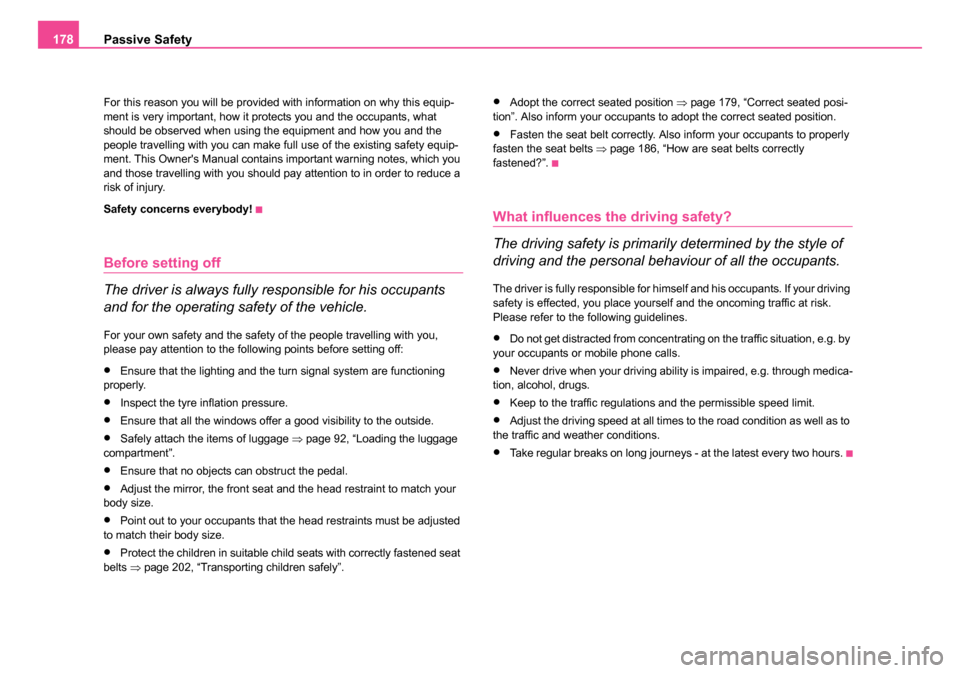
Passive Safety
178
For this reason you will be provided with information on why this equip-
ment is very important, how it protects you and the occupants, what
should be observed when using the equipment and how you and the
people travelling with you can make full use of the existing safety equip-
ment. This Owner's Manual contains important warning notes, which you
and those travelling with you should pay attention to in order to reduce a
risk of injury.
Safety concerns everybody!
Before setting off
The driver is always fully responsible for his occupants
and for the operating safety of the vehicle.
For your own safety and the safety of the people travelling with you,
please pay attention to the following points before setting off:
•Ensure that the lighting and the turn signal system are functioning
properly.
•Inspect the tyre inflation pressure.
•Ensure that all the windows offer a good visibility to the outside.
•Safely attach the items of luggage ⇒page 92, “Loading the luggage
compartment”.
•Ensure that no objects can obstruct the pedal.
•Adjust the mirror, the front seat and the head restraint to match your
body size.
•Point out to your occupants that the head restraints must be adjusted
to match their body size.
•Protect the children in suitable child seats with correctly fastened seat
belts ⇒page 202, “Transporting children safely”.
•Adopt the correct seated position ⇒page 179, “Correct seated posi-
tion”. Also inform your occupants to adopt the correct seated position.
•Fasten the seat belt correctly. Also inform your occupants to properly
fasten the seat belts ⇒page 186, “How are seat belts correctly
fastened?”.
What influences the driving safety?
The driving safety is primarily determined by the style of
driving and the personal behaviour of all the occupants.
The driver is fully responsible for himself and his occupants. If your driving
safety is effected, you place yourself and the oncoming traffic at risk.
Please refer to the following guidelines.
•Do not get distracted from concentrating on the traffic situation, e.g. by
your occupants or mobile phone calls.
•Never drive when your driving ability is impaired, e.g. through medica-
tion, alcohol, drugs.
•Keep to the traffic regulations and the permissible speed limit.
•Adjust the driving speed at all times to the road condition as well as to
the traffic and weather conditions.
•Take regular breaks on long journeys - at the latest every two hours.
s24s.book Page 178 Thursday, November 24, 2005 12:27 PM
Page 180 of 315
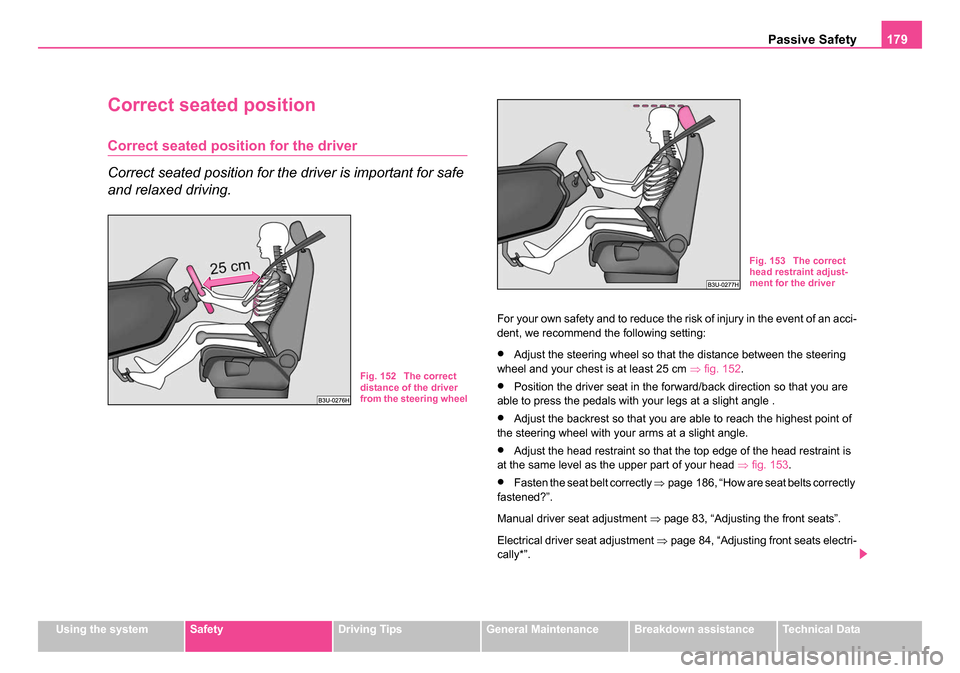
Passive Safety179
Using the systemSafetyDriving TipsGeneral MaintenanceBreakdown assistanceTechnical Data
Correct seated position
Correct seated position for the driver
Correct seated position for the driver is important for safe
and relaxed driving.
For your own safety and to reduce the risk of injury in the event of an acci-
dent, we recommend the following setting:
•Adjust the steering wheel so that the distance between the steering
wheel and your chest is at least 25 cm ⇒fig. 152 .
•Position the driver seat in the forward/back direction so that you are
able to press the pedals with your legs at a slight angle .
•Adjust the backrest so that you are able to reach the highest point of
the steering wheel with your arms at a slight angle.
•Adjust the head restraint so that the top edge of the head restraint is
at the same level as the upper part of your head ⇒fig. 153 .
•Fasten the seat belt correctly ⇒page 186, “How are seat belts correctly
fastened?”.
Manual driver seat adjustment ⇒page 83, “Adjusting the front seats”.
Electrical driver seat adjustment ⇒page 84, “Adjusting front seats electri-
cally*”.
Fig. 152 The correct
distance of the driver
from the steering wheel
Fig. 153 The correct
head restraint adjust-
ment for the driver
s24s.book Page 179 Thursday, November 24, 2005 12:27 PM